Explore key tools, smart features, and expert insights...
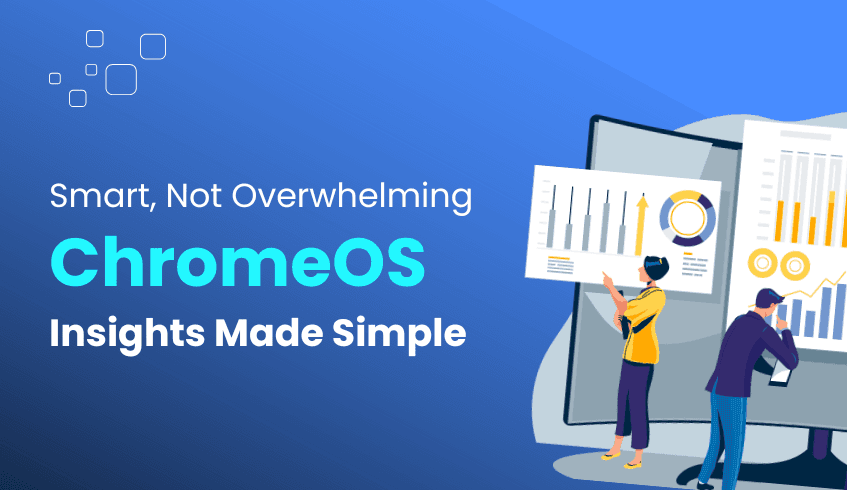
Modernizing IT infrastructure and moving to cloud-first environments like ChromeOS requires more than just a vision; it demands a clear understanding of your current landscape. The ChromeOS Readiness Tool plays a critical role in this transformation, offering detailed insights that help organizations translate raw compatibility data into actionable migration strategies.
The ChromeOS Readiness Tool is a comprehensive compatibility assessment platform. It captures essential data from your existing IT environment including application usage, device specifications, and peripheral integrations providing a data-driven foundation for planning your ChromeOS migration.
By eliminating assumptions and presenting factual insights, the tool sets the stage for a seamless and informed transition.
The tool categorizes applications and devices based on their compatibility with ChromeOS:
Application Readiness:
ChromeOS Ready – Fully compatible and migration-ready.
Possibly Ready – Likely compatible, but may need additional configuration.
Blockers – Incompatible and require remediation or replacement.
Unknown – Currently under analysis and updates are regularly added to the tool’s database.
Device Readiness:
Ready to Switch – Fully compatible and suitable for immediate migration.
Ready with Verification – Mostly compatible but require validation through testing.
Blocked from Switching – Limited by critical dependencies or incompatible apps.
These classifications help IT teams quickly identify migration candidates, organize devices by readiness level or department, and create effective groupings for phased rollouts.
With clearly defined readiness statuses, organizations can move from assessment to execution:
Migrate immediately those devices marked "Ready to Switch" and apps listed as "ChromeOS Ready."
Evaluate and test apps labeled as "Possibly Ready" to prepare them for deployment.
Plan ahead for blockers using virtualization tools like Cameyo, which can help run legacy applications in a ChromeOS environment.
This clarity allows for the development of targeted strategies that reduce downtime and improve user experience during the transition.
Once readiness data is analyzed, a step-by-step migration roadmap can be developed:
Phase 1: Migrate what’s ready – Begin with devices and applications already deemed fully compatible to demonstrate early success.
Phase 2: Pilot with confidence – Test "Ready with Verification" devices and "Possibly Ready" applications in a controlled environment.
Phase 3: Resolve blockers – Address incompatible apps with replacements or virtualization and schedule these users for later phases.
This structured approach ensures that each phase builds on the success of the last while minimizing operational risk.
Migration is not a one-time project, it’s an evolving process. The ChromeOS Readiness Tool provides ongoing support through its real-time, web-based dashboard, offering:
High-level readiness scoring
In-depth breakdowns of devices, applications, peripherals, and browser environments
Exportable reports for deeper analysis using platforms like Power BI, Looker, or Tableau
You can also access historical data to track progress over time and refine your roadmap based on emerging insights or changing business needs.
Although the tool is data-focused, its features naturally support collaboration. Detailed reporting, clear statuses, and downloadable insights make it easy for IT teams to work closely with stakeholders across departments.
The Pro Dashboard and Partner Dashboard offer tailored visibility:
Pro Dashboard: Enables internal IT leaders to manage and monitor their organization’s readiness journey.
Partner Dashboard: Allows partner organizations to manage multiple clients, securely viewing each company’s readiness data.
This shared visibility improves communication, aligns stakeholders on next steps, and ensures decisions are grounded in real-world data.
The ChromeOS Readiness Tool goes beyond analysis, it empowers action. By leveraging its insights, organizations can confidently navigate the complexities of migration, prioritize efforts based on real data, and create a clear, phased roadmap to ChromeOS.
With the right strategy and tools, digital transformation isn’t just possible it’s inevitable.
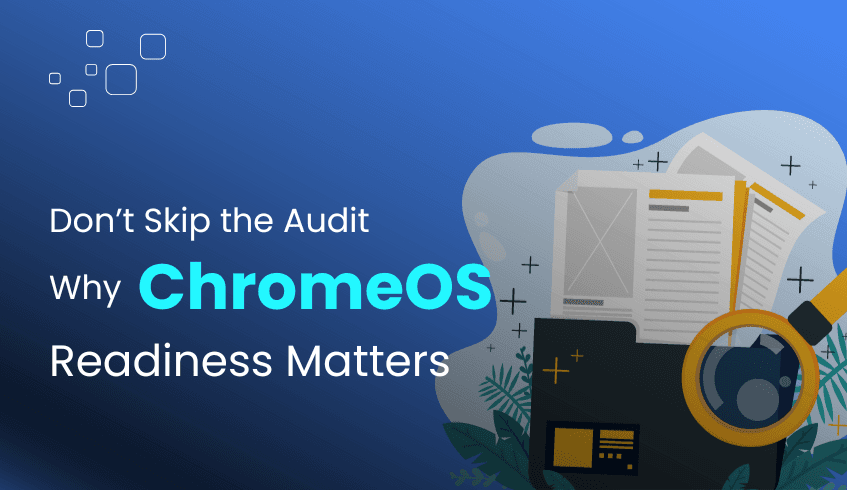
In today’s digital-first workplace, transitioning to a cloud-based operating system like ChromeOS brings clear benefits, enhanced security, centralized management, and cost-efficiency. But without a structured pre-migration audit, even the most promising migration strategy can face unexpected hurdles. That’s where the ChromeOS Readiness Tool becomes indispensable.
ChromeOS Readiness refers to how compatible and prepared your current IT environment is for adopting ChromeOS or ChromeOS Flex. The ChromeOS Readiness Tool provides a comprehensive compatibility assessment by analyzing:
Application usage and compatibility
Device readiness and hardware capabilities
Peripheral and browser integration
These insights help IT teams make informed, confident decisions ahead of migration.
Skipping a proper readiness audit can lead to disruption, unnecessary costs, and technical bottlenecks. Here’s why the ChromeOS Readiness Tool should be part of your pre-migration strategy:
Reduces Surprises: It gives you a clear view of your current environment, eliminating guesswork and identifying potential blockers early.
Saves Time and Cost: Early insights into compatibility challenges reduce downtime and avoid costly remediation later.
Identifies Critical Blockers: Applications and devices are categorized by readiness ChromeOS-ready, Possibly ready, Blockers, or Unknown. For blockers and possibly ready applications, the tool even recommends virtualization solutions like Cameyo, enabling quick alternatives.
The tool provides in-depth visibility across essential readiness checkpoints:
Device Compatibility: Devices are tagged as Ready to Switch, Ready with Verification, or Blocked from Switching, giving you clarity on which endpoints need attention.
Application Readiness: All Windows apps are analyzed and grouped based on their compatibility with ChromeOS. Apps needing virtualization are clearly marked with expert suggestions.
Browser & Extension Usage: Through Browser Insights, you get detailed data on browser types, versions, and extensions across your fleet.
Security & Data Handling: The tool ensures all collected data remains within your organization. Access to the web dashboard requires the original private key generated at deployment, ensuring only authorized users can view data as the private key is unique for each deployment.
Deployment Flexibility: Choose between Enterprise Flow (Active Directory setups with local network storage) or Other Deployment Options Flow (for Unified Endpoint Management environments using cloud storage). The tool is designed to adapt to your organization’s structure.
A comprehensive pre-migration audit helps your organization:
Mitigate Migration Risks: Avoid compatibility issues and disruptions by identifying problems early.
Plan Strategically: Prioritize fixes using clearly categorized readiness statuses and expert recommendations.
Roll Out in Phases: Enable controlled, phased migration by understanding device and application readiness at scale.
To get the most from the ChromeOS Readiness Tool:
Use its intuitive web-based dashboard to track overall readiness scores and deep-dive into device and app-level reports.
Export raw reports in Excel for further analysis or integrate with visualization platforms like Looker, Tableau, or PowerBI for advanced dashboards.
Review expert tips and new features regularly through the tool’s “What’s New” section of the ChromeOS Readiness Tool Website.
A pre-migration audit is a vital step to ensure a smooth, secure, and successful transition to ChromeOS. The ChromeOS Readiness Tool empowers IT teams with visibility, control, and confidence.
Start strong. Audit early. Migrate smarter.
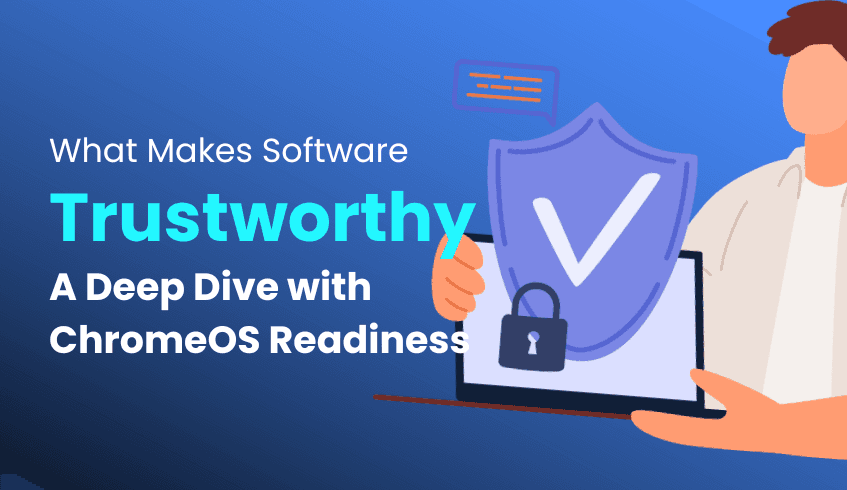
In today’s digital business landscape, software trust isn’t just about features, it’s about how the tool protects your data, communicates transparently, and gives you control. This is especially critical for tools handling sensitive IT assessments, like the ChromeOS Readiness Tool.
Let’s explore what makes software trustworthy and how the ChromeOS Readiness Tool meets those standards.
When evaluating a software solution, especially in the enterprise space, look for these essential qualities:
Data Privacy & Protection – Ensures your organization’s data is handled securely and kept private.
Transparency – Clearly communicates what data is collected and how it’s used.
Strong Security Standards – Uses industry-leading encryption and secure access protocols.
User Control – Gives admins control over configurations, data collection, and access.
Reliability – Performs consistently with minimal downtime or errors.
Vendor Integrity – Comes from a reputable provider committed to support and continuous improvement.
Compliance – Meets industry standards such as GDPR and data-handling best practices.
The ChromeOS Readiness Tool is purpose-built to meet the above criteria with a focus on security, transparency, and user empowerment:
Data Stays Within Your Organization Data is temporarily stored on employee devices and pushed to your designated storage never sent to external servers or locations without your control.
End-to-End Encryption Data is encrypted locally, and only authorized systems can decrypt it using private keys.
Private Key Based Dashboard Access To access readiness data on the web dashboard, the original deployer must upload the private key generated during setup. This adds a strong layer of access control.
Admin-Only Data Access Only authorized personnel can access collected data. Employees or client device users cannot view results stored in shared folders.
GCP Cloud Storage Control For users integrating with Google Cloud, access to storage is admin-configurable, reinforcing privacy.
No Third-Party Data Sharing The tool avoids unsanctioned third-party tracking. Even features like Browser Insights require admin approval before collecting data.
Self-Healing & Reliable The tool automatically restarts key services if interrupted, ensuring consistent performance without manual intervention.
Clear Documentation & UX The tool includes a user-friendly dashboard, setup guides, and expert insights, ensuring full transparency from installation to reporting.
Frequent Updates & Visible Versioning Regular updates improve accuracy and add new features. The version is clearly displayed, and users are notified of changes through a “What’s New” section.
Security-First Approach From data encryption to key management, the tool is designed with enterprise-grade security in mind.
Transparent Feature Controls Admins retain full control over features and data collection policies, enhancing both compliance and customization.
Trustworthy software doesn't just deliver functionality, it safeguards your data, keeps you informed, and adapts to your control. The ChromeOS Readiness Tool embodies these principles, making it a reliable partner for organizations preparing to migrate to ChromeOS.
By combining robust security with clear documentation and continuous improvement, it sets a high bar for trust in enterprise IT tools.

Migrating to ChromeOS is a strategic move toward a more secure, agile, and cloud-first IT environment. While the decision to switch is often backed by thorough readiness planning, the real impact begins in the first 30 days post-migration.
Here’s what your organization can expect in that initial month.
Thanks to prior assessments using the ChromeOS Readiness Tool, most compatibility issues are addressed before migration. This means fewer surprises post-migration and a smoother rollout.
You’ll notice:
Fast deployment with minimal downtime
Centralized device management through the cloud
Quick onboarding and a user-friendly interface reduce the learning curve
ChromeOS is built with multi-layered security, including:
Verified boot and sandboxing
Automatic system and security updates
Restricted access to sensitive data
Combined with the Readiness Tool’s secure data handling during pre-migration assessment, organizations step into a more controlled and protected environment from day one.
ChromeOS thrives in cloud-based workflows. Within the first 30 days, teams will experience:
Real-time collaboration via Google Workspace tools
Easy access to files and systems from any device
Better alignment with hybrid and remote work models
With features like zero-touch enrollment and cloud-based device provisioning, scaling becomes effortless. IT teams spend less time on manual configurations and more on strategic initiatives.
The first 30 days are just the beginning. ChromeOS devices continue to deliver value through:
Up to 10 years of automatic updates
Energy-efficient performance
Ongoing enhancements to the ChromeOS Readiness Tool for better insights and recommendations
In conclusion, if properly planned, the first 30 days post-ChromeOS migration will reflect increased productivity, improved security, and simplified IT operations. Backed by a solid readiness assessment, this transition sets the stage for long-term efficiency and scalability.
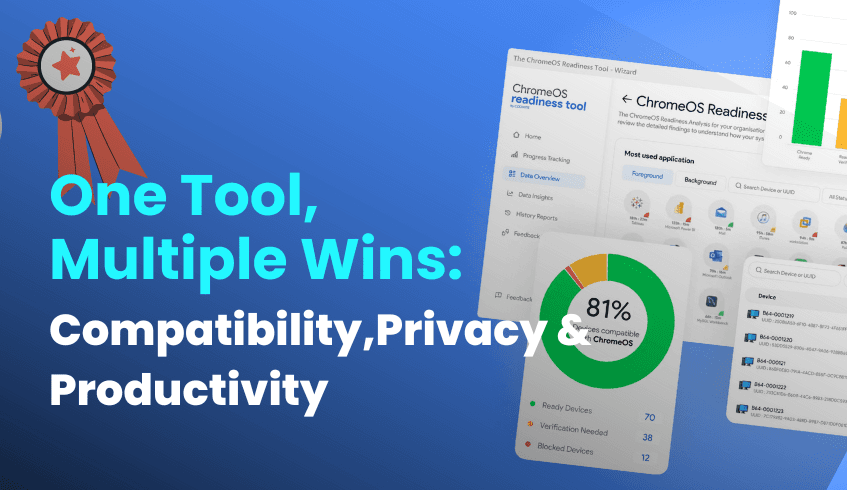
When preparing for a transition to ChromeOS, having the right insights at your fingertips is key. The ChromeOS Readiness Tool offers a focused, all-in-one solution that evaluates application, device, and peripheral compatibility while also upholding the highest standards of privacy and operational efficiency. Designed to help organizations make confident, data-driven decisions, it delivers three critical advantages:
Compatibility assurance
Data protection
Streamlined IT operations.
At its core, the ChromeOS Readiness Tool performs a comprehensive compatibility assessment across your IT environment. It categorizes Windows applications into ChromeOS-ready, Possibly ready, Blocker and Unknown apps giving you a clear view of which ones can migrate easily and which may need further attention. Similarly, devices are labeled as Ready to Switch, Ready with Verification, or Blocked from Switching.
Beyond application and device data, the tool analyzes peripheral device readiness, and with its new Browser Insights feature, it reveals detailed browser usage, versioning, and extension activity. This level of insight helps IT teams manage web environments efficiently and supports integration with Chrome Enterprise Browser. The tool also supports virtualization planning by flagging apps that may need it and recommends Cameyo as a supported solution.
Privacy is a foundational pillar of the ChromeOS Readiness Tool. All collected data remains under your organization’s control and never shared or uploaded to the GCP without your consent as per the storage location chosen.
Access is tightly controlled, only those with the deployment generated private key can view readiness results. Employee access to stored assessment data is also restricted at the folder level.To further support compliance, a GDPR Compliance & Data Security Document is made available on the website .
The tool’s automated assessments remove ambiguity from the planning process, enabling faster, more strategic decision-making:
Centralized Dashboards: IT teams gain a unified view of readiness metrics eliminating the need for manual tracking or distributed audits.
Faster Planning: With categorized results for apps, devices, and peripherals, migration strategies can be prioritized effectively.
Scalable IT Rollouts: Pairing ChromeOS Readiness Tool assessments with features like zero-touch enrollment and cloud-based policy management empowers organizations to scale device provisioning with minimal hands-on setup.
The ChromeOS Readiness Tool is more than a compatibility checker. It’s a strategic enabler that blends transparency, powerful insights, and secure design into one platform. For organizations preparing to migrate their IT environments, it delivers measurable wins enhancing decision-making, protecting sensitive data, and accelerating the path to ChromeOS with clarity and confidence.
Ready to take the next step? Visit chromeosreadinesstool.com, schedule a demo, and begin evaluating your readiness with a tool built for today’s enterprise needs.

In today’s fast-paced business landscape, organizations are under pressure to adopt modern, efficient, and secure IT solutions. While transitioning to ChromeOS presents significant benefits, the manual process of auditing applications and devices often becomes a major bottleneck consuming time, increasing costs, and delaying decision-making.
The ChromeOS Readiness Tool eliminates these inefficiencies by automating the readiness assessment process, saving your IT team countless hours and offering a smarter path to migration.
Traditionally, preparing for an OS migration involves manually:
Logging application usage and compatibility
Assessing individual device readiness
Identifying potential “blocker” applications
This process is slow, error prone, and resource intensive, especially across large, distributed environments.
The ChromeOS Readiness Tool replaces this manual workload with automated, intelligent assessments. Here's how:
The tool categorizes existing Windows apps into four clear statuses: ChromeOS-ready, Possibly Ready, Blocker, and Unknown. This eliminates ambiguity and provides actionable insight for migration planning.
With built-in support for Active Directory environments, the tool deploys automated agents to gather device-level data. In other deployment options flow, while initial setup is manual, the assessment process remains automated. Data is securely stored on employee devices and pushed to your chosen cloud or local storage.
Manually tracking browser usage and extensions across devices is difficult. Browser Insights provides centralized visibility into browser versions and extension data, helping IT teams identify potential risks, enforce policies, and streamline browser standardization.
Devices are automatically classified as Ready to Switch, Ready with Verification, or Blocked from Switching, giving IT teams an immediate understanding of the ability to switch to ChromeOS.
By eliminating the need for manual audits, the ChromeOS Readiness Tool delivers measurable value across the organization:
Reduce audit time from weeks to hours. Proactively identify challenges and minimize delays or budget overruns.
Automated insights for your IT team to focus on high-impact tasks rather than data collection. The intuitive dashboard offers a consolidated view of readiness metrics, trends, and actions needed.
With accurate app and device data, planning becomes more predictable and efficient. You can identify pilot groups, prioritize fixes, and streamline deployment phases.
The tool goes beyond diagnostics. It highlights apps that may require virtualization and suggests solutions like Cameyo, reducing the technical complexity of running legacy software.
Whether deploying hundreds or thousands of devices, the tool supports centralized management, ensuring your IT infrastructure is ready to scale as your business grows.
All data collected by the tool is encrypted using strict access controls in place. Data remains within your organization’s environment, ensuring security and compliance at every step.
The ChromeOS Readiness Tool offers more than automation, it provides clarity, control, and confidence. Say goodbye to time consuming manual audits and hello to a data-driven, secure, and future-ready migration experience.
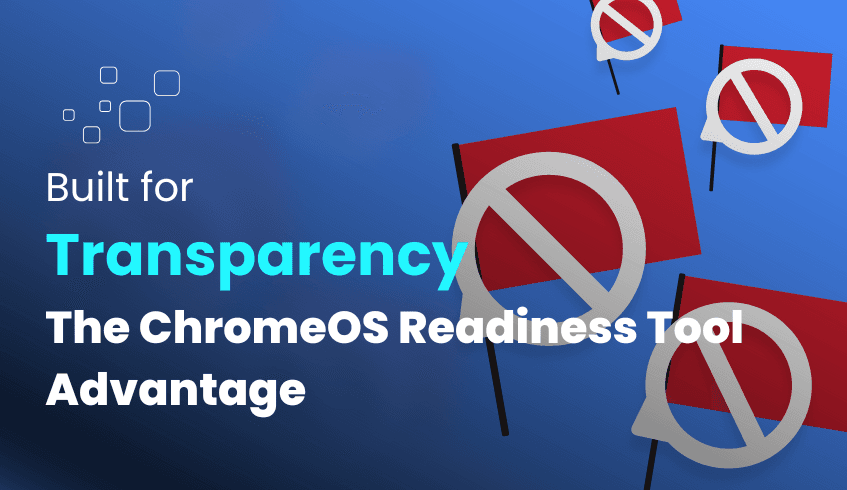
In today’s digital landscape, transparency and data control are critical when adopting enterprise IT solutions. As organizations evaluate tools to support their migration to ChromeOS, they need assurance that their sensitive data is being handled securely and responsibly. The ChromeOS Readiness Tool not only provides a detailed assessment of device and application compatibility, but it also sets a high benchmark for transparency in how data is collected, stored, accessed, and protected throughout the migration journey.
Transparency in the context of the ChromeOS Readiness Tool means giving your organization complete visibility and control over its data. You know exactly:
What data is collected
How is it protected
Who can access it
All of this is built into a secure framework designed to minimize risk and build trust throughout your transition to ChromeOS.
All data collected during assessments remains within your organization’s ecosystem.
There is no automatic sharing with external servers or third parties.
Data is first temporarily stored on employee devices, and only then uploaded to your designated storage location, ensuring full control over data flow.
Strict internal policies protect the encryption keys themselves, preventing unauthorized access.
Only authorized personnel with the right permissions can access the shared folder containing assessment data.
Access to the web dashboard is further protected: users must upload the private key generated during deployment to view readiness details.
This ensures that readiness results can only be accessed by the original deployer of the tool or an authorized partner who possesses the corresponding private key, maintaining strict control over sensitive assessment data.
When using GCP cloud storage, organizations must assign the Storage Object Admin role to the tool’s service account, and public access is explicitly discouraged.
Features like Browser Insights are entirely admin-controlled and compliant with your organization’s internal policies.
Data collection only begins once approved by an administrator.
Admins can set specific data collection periods based on organizational needs and compliance frameworks.
The tool provides an intuitive web dashboard with:
A high-level readiness overview
Compatibility breakdowns
Device readiness assessments
Application and peripheral insights
This ensures that IT teams have full visibility into the organization’s readiness without needing to interpret raw logs or backend data.
The ChromeOS Readiness Tool goes beyond basic assessments, it provides enterprise-grade transparency and security every step of the way. By ensuring that data is encrypted, access-controlled, admin-managed, and never shared externally without consent, the tool builds confidence among IT decision-makers.
As your organization prepares for a cloud-first future with ChromeOS, you can move forward knowing that your data remains secure, private, and completely under your control. With no red flags and full visibility, the ChromeOS Readiness Tool truly sets the standard for transparency in IT readiness solutions.
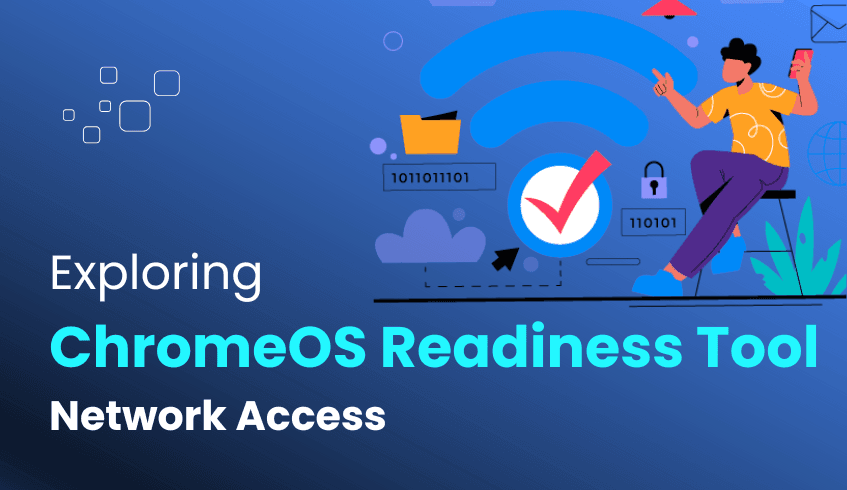
When preparing for a large-scale migration to ChromeOS, one common concern among IT teams is how well the tools perform in environments with limited or unreliable internet access. The ChromeOS Readiness Tool is designed with flexibility in mind, enabling local data collection even when immediate connectivity isn't available. This ensures organizations can begin collecting critical readiness data without delay, supporting a seamless transition regardless of network conditions.
The ChromeOS Readiness Tool functions through a data collection agent installed on employee devices. This agent is designed to track all processes, monitoring the start and stop times of applications. It specifically logs open window applications and predefined background applications.
A key feature for environments with unstable connectivity is that the collected data is temporarily stored directly on employee devices. This local storage mechanism allows initial data acquisition to continue uninterrupted, even when the device cannot immediately connect to a network or the internet.
For instance, the Browser Insights feature, which provides a comprehensive view of browser usage, versions, and extension data, follows the same model. Collected data is temporarily stored on devices before being uploaded to the designated storage. Additionally, the tool ensures security by encrypting log files locally, adding a layer of protection before the data leaves the device.
While initial data collection and local storage do not require connectivity, the next steps, aggregation, encryption, upload, and analysis do require a network or internet connection.
The data service component is responsible for reading the stored logs, encrypting them, and uploading them to the designated storage. The ChromeOS Readiness Tool supports multiple storage options, each with specific connectivity needs:
Network Shared Folder (Enterprise Flow): Results can be stored in an on-premise network shared folder, requiring only an internal network connection.
GCP Cloud Storage Bucket (Enterprise or PowerShell Flows): Uploading to a GCP Cloud storage bucket requires internet access and appropriate permissions (e.g., Storage Object Admin role) granted to the tool’s service account within your GCP project.
If a PC is powered off, data will not upload until the device is powered on and connected to the network or internet.
Detailed assessment insights are accessible via an intuitive web-based dashboard. To view the data, administrators must upload the private key generated during deployment and sign in using a Google account. As expected, this requires internet access.
The Pro Dashboard is available by default in the PowerShell Flow, and with the Enterprise Flow only when using GCP Cloud storage.
The Partner Dashboard is enabled through a service provider and also requires GCP Cloud storage.
This architecture local collection with centralized reporting offers the following benefits:
Continuous Data Capture: Even with limited connectivity, employee devices collect data locally, reducing operational disruptions.
Secure Data Handling: All data remains within your organization, ensuring full lifecycle security.
Flexible Deployment: The tool works seamlessly across on-premise and cloud-native infrastructures.
The ChromeOS Readiness Tool supports efficient local data collection and temporary on-device storage, making it well-suited for environments with intermittent connectivity. However, full data processing, secure aggregation, and the ability to view readiness reports on dashboards require either an internal network (for shared folder upload) or internet access (for GCP Cloud and dashboard access).
The tool emphasizes data security and operational flexibility, but it does not support a fully offline experience for end-to-end readiness reporting. This design balances local flexibility with centralized intelligence, supporting a smooth and secure ChromeOS migration while accommodating real-world connectivity challenges.
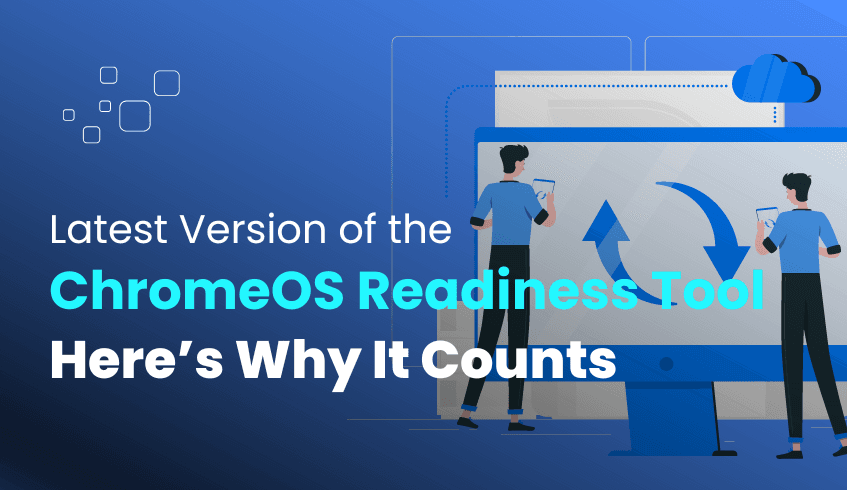
In a fast-moving digital world, tools that adapt and evolve offer a strategic advantage. The ChromeOS Readiness Tool is built not just for one-time assessments but to grow with your organization’s needs. Updating to the latest version isn’t simply about maintenance, it’s about unlocking smarter insights, stronger features, and a smoother migration journey.
While staying informed is important, implementing the latest updates is what transforms the actual usability of the tool. Here’s how updates directly impact your experience:
Each update enhances the tool’s ability to monitor application activity and device readiness with greater precision. This helps reduce misclassification and gives IT teams better context to prioritize migration plans.
New releases often introduce dashboard enhancements such as the Virtualization section in the Pro and Partner views. This includes Cameyo recommendations to help manage "Blocker" or "Possibly Ready" apps more effectively. These added capabilities provide expanded visibility and decision support.
Updated versions provide richer reports that surface deeper trends around software usage, peripheral compatibility, and real-time readiness. This enables teams to connect technical assessments to strategic business outcomes.
Choosing to keep your ChromeOS Readiness Tool updated ensures:
You’re using the most relevant and accurate compatibility standards.
Your dashboards reflect the latest features and usability improvements.
Your team has access to fine-tuned insights aligned with current ChromeOS migration trends.
As the tool continues to evolve, each version reflects real-world feedback, user experience refinements, and support for emerging ChromeOS use cases. By staying current, your organization doesn’t just react to change it stays ahead of it.